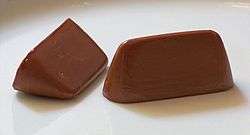Gianduiotto
The gianduiotto (IPA: [dʒanduˈjɔtto]; Piedmontese: giandojòt [dʒaŋdʊˈjɔt]) is chocolate originally from Piedmont, in northern Italy, they are shaped as ingots. Gianduiotti are individually wrapped in a tinfoil cover, usually gold or silver-colored. It is the speciality of Turin, and takes its name from gianduja, the preparation of chocolate and hazelnut that is used for gianduiotti and other sweets (including Nutella and bicerin di Gianduiotto); in turn, this preparation is named after Gianduja, a mask in commedia dell'arte that represents the archetypal Piedmontese. Indeed, Gianduja's hat inspired the shape of the gianduiotto.
 | |
| Type | Chocolate |
|---|---|
| Place of origin | Italy |
| Region or state | Piedmont |
| Main ingredients | Gianduja (sugar, cocoa, hazelnuts) |
Gianduiotti are produced from a paste of sugar, cocoa and hazelnut Tonda Gentile delle Langhe. The official “birth” of gianduiotti is set at 1852 in Turin, by Pierre Paul Caffarel and Michele Prochet, the first to completely grind hazelnuts to a paste before adding them to the cocoa and sugar mix.[1]
Apparently, the idea of mixing hazelnut pieces to “standard” chocolates was born during Napoleon’s reign, when importing cocoa from South America became difficult. “Raw” cocoa was expensive, so local producers started incorporating bits of roasted hazelnuts (hazelnuts are locally grown and were easy to come by in Piedmont) to make the final product more affordable.